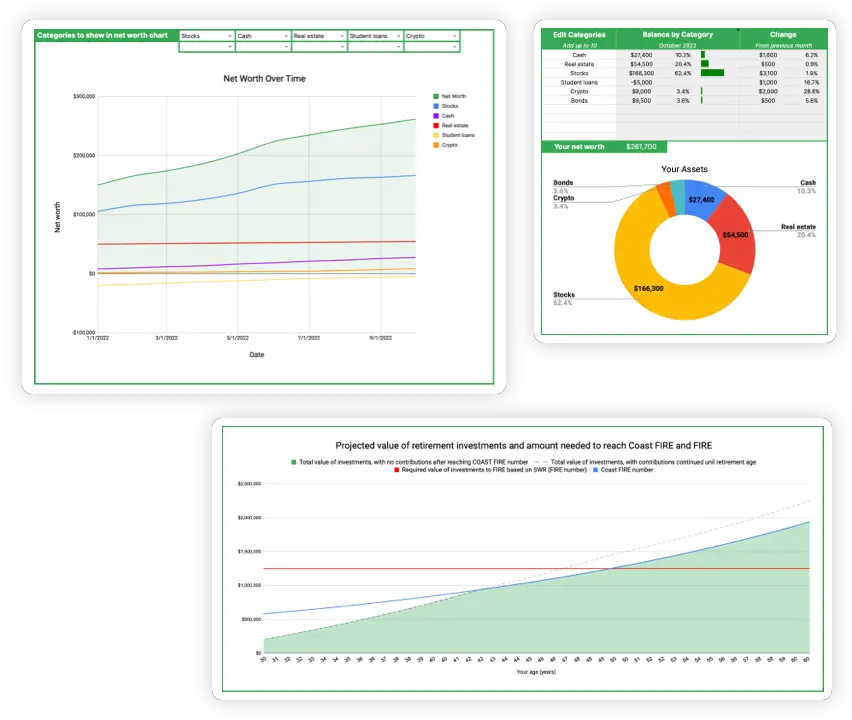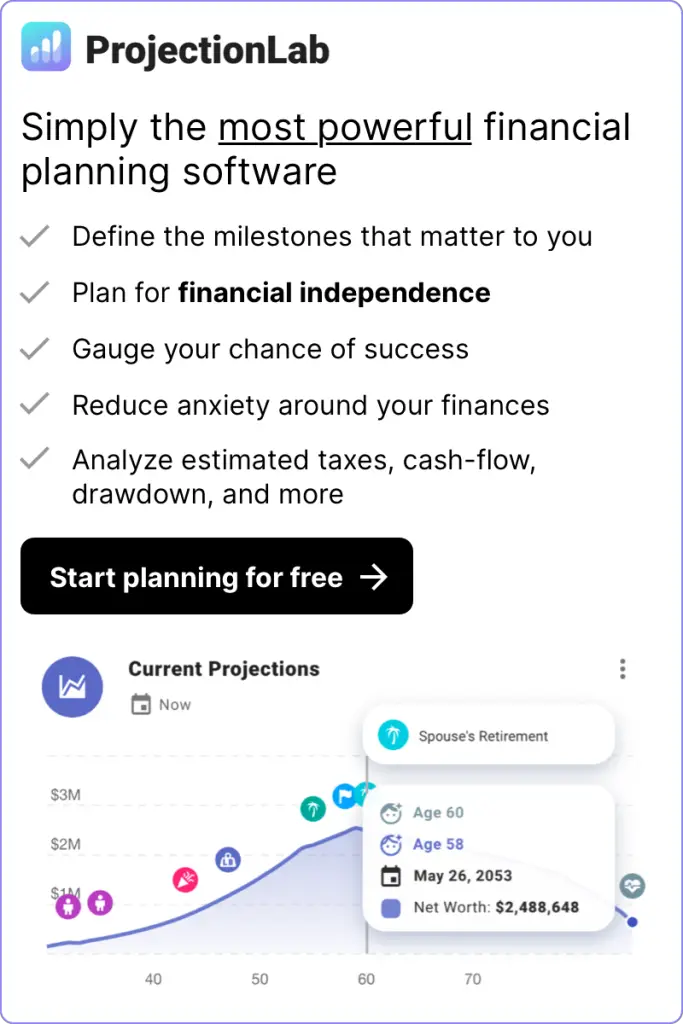Calculate the cash-on-cash return for your next real estate investment
Take your wealth planning to the next level with my Wealth Planning Toolkit for Google Sheets – just $20.
Plan for recurring monthly income over different time periods as well as windfalls and one-time purchases in the future.
Includes 10 year Net Worth Tracker with Dashboard, Asset Rebalancing Calculator, and advanced FIRE and Coast FIRE Calculators.

Summary
- Cash-on-cash return tells investors the annual cash yield of an investment relative to the upfront cash invested in the deal.
- It takes into account the cost of long-term debt used to finance a property purchase.
- Because real estate purchases often involve long-term debt financing, cash-on-cash return is preferred over standard return-on-investment (ROI) for deal analysis.
- This tool calculates the cash-on-cash return for a potential real estate investment based the financal details that you input for the deal.
What is cash-on-cash return?
Cash-on-cash return, or put simply the cash yield, is a key metric that tells real estate investors the annual cash yield of an investment relative to the upfront cash invested in the deal.
Cash-on-cash (CoC) return is particularly useful because it takes into account the long-term debt used to finance a property purchase. For this reason, it is considered to be one of the most important real estate ROI calculations. Since debt is often used to purchase real estate investments, cash-on-cash return is preferred over standard return-on-investment (ROI) for deal analysis.
Cash-on-cash return is calculated on a pre-tax basis.
How to calculate cash-on-cash return?
The formula for calculating cash-on-cash return is straightforward:
CoC return = annual net cash flow (pre-tax) / invested cash
This calculator is designed to help you to quickly calculate the cash-on-cash return for a property.
In the Annual breakdown over 20 years table you can see the cash-on-cash return for the property over each year during the holding period. If your annual cash flow increases over time (based on your annual increase numbers for each input), then cash-on-cash return will also increase over time because the upfront cash investment in the deal is unchanged.
Why does it matter?
Cash-on-cash return is among the most important ROI metrics for real estate investors because it measures a property’s ability to produce cash flow given an initial investment.
This makes cash-on-cash return particularly useful for investors seeking cashflow from their real estate investment.
As a real estate investor, you can use the cash-on-cash return to compare the relative ability of different properties to produce cashflow.
What is a good cash-on-cash return?
What is considered a good cash-on-cash return depends on the local market and your expectations for future appreciation as an investor. Higher is generally better when it comes to cash-on-cash return, and some investors may be happy with 5% to 10% cash-on-cash returns while others may target above 10%.
A low cash-on-cash return may indicate that a property has too low of rents, too high of a vacancy rate, or is simply overvalued.
A low or negative cash-on-cash return does not necessary mean that you should avoid an investment completely, but you should look at it critically. Low cash-on-cash returns are often associated with high-appreciation real estate markets, but just because the cash-on-cash return is low does not mean that a property is more likely to appreciate.
If you are investing with an eye towards cash-flow, then a low or even negative cash-on-cash return should be concerning because it means that you should expect minimal cash-flow given your investment.
Cash-on-cash return vs cap rate
The cash-on-cash return metric is similar to the capitalization (cap) rate metric, however they are not exactly the same.
The cap rate is calculated by dividing a property’s Net Operating Income (NOI) by the value of the property.
If a property is purchased in cash with no financing, then the cash-on-cash return is the same as the cap rate.
The difference between the two metrics becomes apparent when you evaluate a property purchased with long-term debt.
Cash-on-cash (CoC) return is useful because it takes into account the cost of long-term debt used to finance a property purchase, unlike the capitalization (cap) rate which is independent of financing.
Depending on the interest rate used to finance the investment, a property’s cash-on-cash return may be higher or lower than the cap rate.
Here are some details to help you understand all of the inputs that the calulator takes into account in order to calculate the projected cash-on-cash return for your real estate investment:
Property purchase inputs
Purchase price is the price you pay to buy the property, not including closing costs.
Down payment is the percentage of the purchase price you pay out-of-pocket. The typical down payment for investment properties is 20 to 25%, but for owner-occupied real estate, you may be able to put down as little as 3.5% with an FHA loan. If you’re buying the property in cash, then you should set this value to 100%.
Interest rate is the fixed interest rate on your loan which you would pay off over the loan duration.
Loan duration is the length of time over which you will pay off the loan. The most common loan durations in the USA are 30-year and 15-year.
Closing costs are processing fees that you pay to your lender to obtain your mortgage and include things like Applications fees, Appraisal, and Loan Origination fees. Closing costs are typically between 3% and 6% of your loan amount.
Rehab costs are the costs of any improvements that you make to the property after purchasing it and before you rent it out.
Income inputs
Monthly rent is the total value of rent that is collected from your tenants each month. This does not include property management fees.
Vacancy rate is the percentage of time when your property is unoccupied and you are not collecting rent from a tenant. One month of vacancy per year implies an 8% vacancy rate.
Property Management fee. If you do not manage the rental yourself, you will need to hire a property manager to do so. Property managers typically charge 10% of the monthly rent as a fee.
Yearly expense inputs
Property taxes are based on the assessed value of your property and vary by state, county, and locality that the property is located in. State property tax rates as a percentage of property value range from 0.28% in Hawaii to 2.49% in New Jersey.
Landlord insurance protects your property against damage and also provides personal liability coverage. It protects your property against damage from natural disasters like storms, lightning, and hail as well as fire damage and damage from tenants. Generally landlord insurance costs about 15% more than homeowner insurance. Landlord insurance varies by geographic region as well as size, value, and age of your property. The national average for landlord insurance is $1,288 per year.
You will need to budget for Homeowner’s Association (HOA) fees if your property is in an HOA. HOA fees are standard for condos, apartments, and single-family homes in planned communities and are used to pay for amenities, property maintenance and repairs. These fees will vary by property and location but typically range between $200 and $300 per month.
Budgeting for maintenance of your property is important to keep it in good condition and to be prepared for unexpected repairs that may come up. Neglected maintenance can often cause bigger, more expensive problems down the line, so being proactive with maintenance will save you money and headaches over the long term. A common rule of thumb is the 1% of property value formula, which says that you should budget for 1% of your property’s value to be spent each year on maintenance. Factors like age and condition of your property will influence the amount of maintenance required.
Other expenses is a bucket for any other miscellaneous expenses that you anticipate. This could include utilities like water, sewer, gas, or trash collection or things like landscaping or snow removal.
Sale inputs
Sale price is the price that you expect to sell the property at the end of the holding length.
Holding length is the length of time in years that you plan to keep the property as a rental before selling it.
Sale expenses depend on the value of your property and typically total 8 to 10% of the sale price. As a seller, your biggest sale expense is typically the commission to your real estate agent, with a national average commission coming in at 5.8% of the property sale price. Closing costs are the second biggest sale expense at 1-3% of the sale price. Closing costs are related to the transfer of ownership of the property to the buyer and include things like title fees, settlement fees, and transfer taxes. You may also want to budget for repair, preparation, and staging of your property to maximize your sale price.

